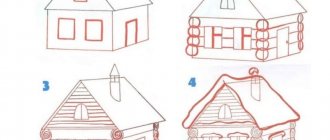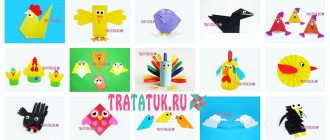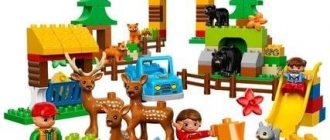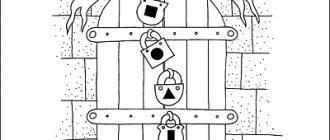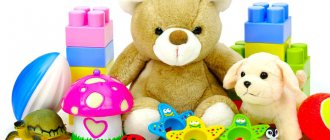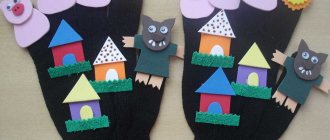Senior group. Senior preschool age. Children 5-6 years old
Lesson summary for children of the senior group “City for Lego men” “City for
Lego men ” (senior group)
Educational areas: artistic and aesthetic development.
Integration of activities: cognitive - research, gaming, communicative. Lexical topic: “A city for
Lego men ” Type of activity: collective -…
Abstract of the OOD "Travel with Dunno" using a Lego constructor in the senior group. Abstract of an OOD using a Lego constructor in the senior group . Topic “Transport”
“Travel with Dunno”
Objectives: Develop interest in creating variable
designs from Lego material . Update your understanding of different types of transport, the ability to systematize objects...
Abstract on light engineering on the topic: “Design of houses, urban landscape.”
Open lesson on Lego design.
Topic: Design of houses, urban landscape. Goal: To get acquainted with the housing of different peoples and nationalities, the basic concepts of the urban landscape, to recall the features of urban buildings.
Development of the ability to follow the teacher’s instructions; Development of children's constructive imagination; Development and activation of children's speech; Formation of the ability to work in small groups; To develop an aesthetic taste for architecture. Equipment: LEGO DUPLA sets in sufficient quantities, images of the city landscape, homes of different peoples.
Progress of the lesson
- LEGO warm-up
Guys, before we start our lesson, let's choose a captain in each group.
The teacher gives commands in which the children must take a piece of a certain color and connect it with a certain piece. (The result of the work is a figure similar to a house). The work is done in a circle, starting with the team captain.
- Conversation
What does the resulting model look like? On house.
Listen to the riddle:
Where is our family comfortable? Where does it smell like porridge in the morning? (Houses)
What do you think we will talk about in our lesson today? About the house. What should a house be like? Housing should not only be comfortable, but also durable, adapted to living conditions.
Imagine that you have the necessary building material at your disposal. The question involuntarily arises of how to build, because any business must have its own laws and methods. Have you ever wondered why most houses are rectangular in shape? Acute and obtuse angles are almost never used in construction, except in some decorative structures. Some peoples prefer round dwellings: igloos, yurts? To answer these questions, let’s take a closer look at the dwellings of different peoples.
- Auls, a settlement of mountaineers, resemble swallows' nests. Dwellings are located one next to the other and one above the other (Tajiks, Uzbeks, Chechens) of Central Asia and the Caucasus.
In the Caucasus mountains, especially in Dagestan, an aul is a fortified settlement. Houses in auls are usually built of stone on a mountain slope or against a steep wall to protect the settlement from unexpected attacks. Houses are usually two-story.
Most often, villages are located near rivers or lakes.
2. Yurts - inhabitants of the steppe made a house from felt. (Mongols, Kazakhs, Tatars) Many peoples of Central and Central Asia lived in yurts. For nomadic tribes, this is a very convenient house that can be easily disassembled and transported. The main place in the yurt was occupied by the hearth. Taking a closer look, you realize that the round shape of the home is the most comfortable and rational, allowing everyone to sit around the hearth. In the center of the yurt, a hoop was fixed to four pillars, which was connected to the frame using poles. A hole was left in the cone-shaped roof through which light entered the yurt and smoke came out. The outside of the frame was tied with ropes for stability and then covered with felt. This material is very convenient to use: in cold weather it reliably protects from frost, and when moving, it can be rolled up and placed in a bale. Felt was also used to cover the floors in the yurt.
3. Chums, yarangas - houses made of fur, hunters and reindeer herders of the North are residents of such houses. (Chukchi, Nenets, Nanai) The dwelling of the Evenks - chum - is striking in its simplicity. Its basis is made up of three poles connected at the top. Another 30-50 thinner poles rest on them. The tent is covered with elk skins. True, not everyone could afford such luxury. Those who were poorer made do with larch bark. In the warm season, the tent was covered with boiled birch bark.
The largest and most spacious tent belonged to the shaman, at whose place all the inhabitants of the camp gathered.
- Igloo is a round house made of large sharpened pieces of ice (Eskimos).
As we can see, every nation built houses from the material at hand. What did the inhabitants of the Far North do, where there is only snow around and it is difficult to find a twig or stone? They build their houses - igloos - from snow. After all, snow not only cools, but also warms. It keeps the home warm and prevents frost from penetrating inside. Over time, snow buildings do not collapse, but rather become stronger. The wind helps, depositing new layers of snow on the needle. From the inside, under the influence of people's breath, ice forms, which serves as a frame for the home.
The igloos are heated with a candle or a fat lamp. However, people do not freeze and even strip naked in their “house”.
In what houses did our ancestors live and live now? (In wooden houses, huts).
And now what kind of houses do we live in? (wooden, multi-story)
- Where are these multi-storey buildings built?
- Why build high-rise buildings in the city? (Saves space, there are a lot of people)
- Are there such houses in our city?
- What is located in small, one-story buildings? (Shops, cafes, pharmacies...)
- What else besides houses and various buildings is there in our city? (Squares, stadiums, parks...)
- Why do the townspeople need all this?
- What do city dwellers lack? (More trees, parks...)
- What can you and I do to improve our life in the city? (Protect nature)
- Who should work to build such a house?
Name the construction professions. (Builders: painter, carpenter, tiler, roofer, electrician, plumber, plasterer, crane operator, architect, mason, bulldozer operator, excavator operator, etc.). And with a person, what profession does the construction of a house begin with? (Architect). Today we will play the role of an architect.
Now we need to build our own mini project. Each group will have its own task (to build a high-rise building, a one-story building, a square or a playground), after which the commanders of each group must defend their work, tell what you built and for whom.
Commanders choose a mission. Remember that buildings, streets, avenues, boulevards, parks, squares make cities beautiful 3. Independent work with the designer
Children are divided into 3 teams:
1 team builds city high-rise buildings;
2 team urban small houses; 3 team park or playground; 4. Defense and discussion of the resulting projects
Summary of GCD on construction from LEGO - designer in the middle group
Summary of direct educational activities for constructing a “House for a Dog” from a LEGO constructor in the middle group
Teacher of the highest category: Plotnikova Anna Evgenievna MKDOU combined type No. 2 “Beryozka”, Kataysk, Kurgan region Description of the material: Summary of direct educational activities for children of the middle group “ A house for a dog." The material will be useful to teachers of preschool groups. This is a summary of a lesson on building with LEGO construction kits for preschoolers 4-5 years old. Goal: To teach children individual and collaborative design. Program content: Learn to build according to the proposed instructions, taking into account the methods of fastening parts; convey the features of objects using the LEGO constructor; — consolidate the idea of building parts and their properties; determine the purpose of parts of objects, their spatial arrangement; choose the correct sequence of actions; — to form in children a stable interest in constructive activities; desire to experiment, create, invent; - develop attention, ability to concentrate, memory, logical thinking; small muscles of the hands (motility); - develop the ability to analyze, highlighting the characteristic features of an object, functional parts; establish a connection between their purpose and structure; continue to teach how to correctly and quickly navigate in space; — consolidate mathematical knowledge about shape, proportion, symmetry; — cultivate a caring attitude towards animals, respect for one’s own and other people’s work. Equipment: 1. Pictures and toys of different breeds of dogs; kennel images. 2. Baskets with LEGO parts; 3. Finished construction of a dog kennel; 4. Tape recorder or PC: audio recording: “The Barking of a Dog,” the children’s song “Man is a Dog’s Friend.” Preliminary preparation: 1. Watching cartoons, presentations about dogs, the characteristics of their lives; 2. Reading literature, looking at illustrations about dogs. Progress of the GCD: 1. Introductory part. Teacher:
- Hello, guys.
Tell me please, do you have friends? (yes) - What is friendship? Teacher:
- Of course, without friends our life would be boring and uninteresting, we would have no one to play with, share toys, tell secrets, come up with various interesting stories.
Listen to the poem “About Friendship”: The breeze is friends with the sun, And the dew is with the grass. A flower is friends with a butterfly, You and I are friends. Everything with friends in half. We are happy to share! Only friends should never quarrel! (Author: Yuri Entin) Teacher:
- Guys, we can be friends not only with children from kindergarten.
Who else can we be friends with? Who else is called a man's friend? (children's answers) Teacher: - That's right. A dog is man's most devoted friend. She will never let you down or betray you. She protects a person's home. Teacher: - Look at the pictures of dogs. They are all so different. What breeds of dogs do you know? (dachshund, poodle, mongrel, shepherd) Teacher: - Listen, who came to visit us? (dogs can be heard barking) Yes, these are our four-legged friends! Take your favorite and we will go for a walk. (Children move around the group to the children’s song “Man is a Dog’s Friend” (1st verse) and repeat the movements after the teacher, according to the text) Teacher:
- What a nice walk we had with our pets.
Have a seat. Only our favorites were sad. What do you think happened (children's guesses: hungry, tired). Teacher: - And you will find out what happened if you guess the riddle: There is a house in the yard - The owner is on a chain.
(doghouse, kennel)
Teacher:
- That’s what happened, it turns out they don’t have a home.
What is the name of the place where dogs live? (kennel) 2. Main part. Teacher:
- I think that we can help our faithful friends.
We'll make them a kennel like this. And we will build it from LEGO construction kits. Let's look at the dog's house. What main parts does it consist of? (base, kennel itself, roof). Teacher:
- What is the shape at the base of the house?
(rectangular) Teacher:
- Look, what kind of figure does the house itself look like?
(per square) Teacher:
- What shape does the roof look like?
(on the triangle) Teacher:
- What else must be done so that the dog can get into its cozy home?
(entrance) Teacher:
- What can you say about the sizes of these parts?
Where will we use the biggest LEGO pieces? (We use the largest parts of the construction set for the base of the kennel) Teacher:
- What parts does the kennel itself consist of?
(from medium and small parts of the construction set) Teacher:
- What parts of the construction set will we need for the roof?
(triangular parts) Teacher:
- Correct.
We use the largest pieces of the construction set to build the base for the kennel; medium and small for building the kennel itself; Let's complete our construction with triangular parts, making a roof out of them. What color is a dog's kennel? (brown, yellow, green) - Of course, because the owner can paint it with any paint he wants. The roof can be painted a completely different color. And now, before starting work, we will warm our hands. Finger gymnastics “A house for a puppy”
I will build a house for a puppy.
(Raise your hands above your head like a house) And there will be a window in it. (Join the thumbs and index fingers of both hands to form a rectangle) To make a beautiful entrance to it. (Turn your palms towards you and close them with the side ribs, straightening all your fingers) There will be a fence around (Place your hands in front of you in a ring, connecting your fingers) And the dog will guard everything (Put your palms together, bend your index fingers, stick out your thumbs (“ears”) , showed with their little fingers the opening mouth of the “dog” (that is, they depicted a “dog”)) 3. Practical part. Teacher:
- Now let's get to work.
We start by building a base from the largest parts, applying them evenly to each other with the long side. Now let’s build the walls of the kennel on both sides from the middle parts and place them on top of each other. The number of parts should be the same on both sides. We will attach the back wall of the kennel from the same number of parts as the side walls. And we will build the entrance from the smallest parts, attaching them to the side walls of our house. All that remains is to build a roof from triangular parts, connecting them to each other sideways so that the right angle looks up. Teacher:
- Those who have assembled a kennel for their puppy can help others.
Or lay out a rug in front of the kennel from additional LEGO parts. 4. Final part. Teacher:
- All the guys completed the construction of a house for their four-legged friend. Let's start rehoming our pets. (children seat their dogs near their kennel) Look what wonderful houses we have made for our friends. Whose house did you like better? Why? Whose is yours? Why? Who remembers the name of the dog house? (kennel). What material did we use for the construction? (LEGO constructor) Did you like our lesson? What's the most? What new and interesting things did you learn during the lesson? Well done! You did a great job, I liked the way you answered me. Our lesson has come to an end. Thanks to all.
We recommend watching:
Summary of GCD in the middle group “Mushroom Glade” Summary of GCD. My city Zheleznogorsk Summary of GCD in the middle group with elements of experimentation Integrated GCD for speech development and artistic creativity in the middle group
Similar articles:
Lesson summary for the middle group: Safety at home
Summary of a lesson in kindergarten “Receiving guests.” Middle group
Lesson summary for the middle group on the topic: Properties of glass
Lesson in the middle group of kindergarten. Village courtyard
Summary of a lesson on cognitive development in the senior group. Rules of conduct in the circus
